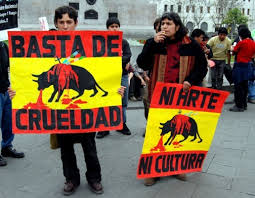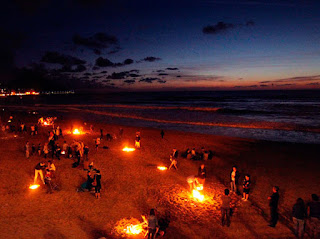 The
Spanish tradition of bullfighting began in the 1700’s, when nobles mounted on
horseback would train by hunting bulls. The sport became very popular, and
bullrings were constructed in towns throughout Spain. The bullring in Ronda is
the country’s oldest, and the one in Madrid is the country’s largest.
Bullfighting continues to be popular throughout Andalusia and in some other
parts of Spain. During the summer months, you can attend a bullfight at the
rings in El Puerto de Santa Maria, Sanlúcar de Barremeda, Ronda, or Sevilla. (Click on each city to reach the link to their bullfight schedule, or search 'toros' or 'taurina' in each city's tourism website.)
The
Spanish tradition of bullfighting began in the 1700’s, when nobles mounted on
horseback would train by hunting bulls. The sport became very popular, and
bullrings were constructed in towns throughout Spain. The bullring in Ronda is
the country’s oldest, and the one in Madrid is the country’s largest.
Bullfighting continues to be popular throughout Andalusia and in some other
parts of Spain. During the summer months, you can attend a bullfight at the
rings in El Puerto de Santa Maria, Sanlúcar de Barremeda, Ronda, or Sevilla. (Click on each city to reach the link to their bullfight schedule, or search 'toros' or 'taurina' in each city's tourism website.) Each fight features three different matadors of varying skill levels, each
usually fighting two bulls. Some have become so popular that they have achieved
celebrity status in Spain. You can purchase tickets either for the sol (sunny) or sombre (shaded) side of the arena. The sun tickets are cheaper,
because they are hotter and the sun is shining in your eyes during the fight.
At a fight, you will first see the matador and his entourage parade into the
ring. Then the bull is released and tested with a series of elaborate cape
movements. Then, picadores mounted on
horses chase after the bull and stab him with lances, which weaken him. The bleeding
bull will charge the horses, but they wear padding to protect them from his
horns. Next, the matador’s assistants try to stick banderillas (sharp sticks) into the bull’s shoulders. Finally, the
matador approaches him on foot and begins the 'art' of bullfighting. He uses a
sword and a short red cape called a muleta,
and encourages the bull to charge in a series of passes. The matador’s
movements are very close to the bull’s horns and body. The fight concludes when the matador kills the bull with his
sword, ideally with a single thrust. (In Portugal, the bulls are not killed in
the ring, but in Spain they are). Warning: there will be blood, and the animal will be killed before your eyes.
Each fight features three different matadors of varying skill levels, each
usually fighting two bulls. Some have become so popular that they have achieved
celebrity status in Spain. You can purchase tickets either for the sol (sunny) or sombre (shaded) side of the arena. The sun tickets are cheaper,
because they are hotter and the sun is shining in your eyes during the fight.
At a fight, you will first see the matador and his entourage parade into the
ring. Then the bull is released and tested with a series of elaborate cape
movements. Then, picadores mounted on
horses chase after the bull and stab him with lances, which weaken him. The bleeding
bull will charge the horses, but they wear padding to protect them from his
horns. Next, the matador’s assistants try to stick banderillas (sharp sticks) into the bull’s shoulders. Finally, the
matador approaches him on foot and begins the 'art' of bullfighting. He uses a
sword and a short red cape called a muleta,
and encourages the bull to charge in a series of passes. The matador’s
movements are very close to the bull’s horns and body. The fight concludes when the matador kills the bull with his
sword, ideally with a single thrust. (In Portugal, the bulls are not killed in
the ring, but in Spain they are). Warning: there will be blood, and the animal will be killed before your eyes.
Please note that Spanish people
currently have mixed views about the ‘sport’ of bullfighting. In some parts of
the country, the practice is outlawed because it is bloody and demonstrates
animal cruelty. The bulls are bred for the ring, and prepared for their fight
with cruel treatments that border on torture. However, supporters argue that it
is an artistic element of Spanish culture and should be preserved as a cultural
event. Whether or not you choose to attend a fight, or watch one on TV, you can
appreciate the importance of the bulls in Spanish traditions.
Excerpt from the book, 'Welcome to Rota.'







